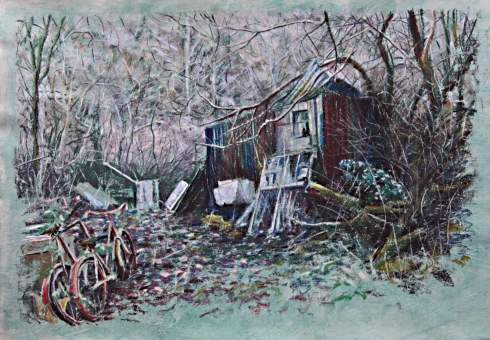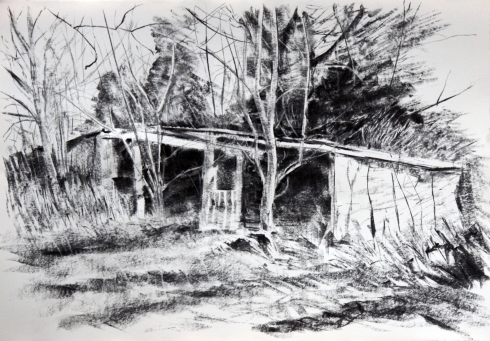Over the early months of this year and on into Spring, I went on walks in Shropshire with some friends of mine, and I recorded my observations of cabins, caravans and sheds of various kinds. (Also see earlier Homely post). Each place was evidently a place of previous or ongoing habitation, mostly by persons unknown. The circumstances of their abandonment are also unknown or ambiguous, but provoking curiosity. Certain of the places were so ramshackle or spartan as to be unlikely places of long term living in any sort of comfort, and were perhaps only used as temporary shelter, or even merely as storage. In their woodland surroundings, these places could be viewed as idyllic retreat or desperate refuge.
The drawings have formed a series entitled “Inhabited”, which I hope to exhibit as a body of work at some stage. As I made drawings, initially in charcoal and later trying out various studies using collage/mixed media, pastels and finally using an ipad, I pondered this precarious living and what it might feel like to exist in these places. My musings have spun off in many directions. We could be looking at post-apocalyptic refuges, or take away the signs of modern technology and detritus, and we could be looking at some form of Mesolithic shelter or the transition to a Neolithic hut.
These first three studies were made from photographs taken in woodland on hills close to the Welsh border (see earlier Motor Plantation post). This first drawing has been selected for the “Eden” exhibition at Participate Contemporary Artspace by curator, Katie Hodson. The exhibition runs from 5th August to 26th August 2017 (11am to 5pm Tues – Sat)

“When Adam Delved”, charcoal on paper, 420mm x 594mm

“Retreat in Winter” charcoal on paper, 420mm x 594mm

“And Eve Span” pastel on paper, 420mm x 594mm
Gaston Bachelard’s “Poetics of Space” was brought to mind as I reflected on my reveries. It seems to be a bit of a cliché at the moment to be referring to that work – since making the connection with my drawings, I have read about three different current art projects also inspired by the book. Nonetheless, it is a book that, as I have found, rewards re-reading and there are clear resonances with Bachlard’s writing as I begin to daydream about all my own experiences of house and home.
“Memory – what a strange thing it is! – does not record concrete duration, in the Bergsonian sense of the word. We are unable to relive duration that has been destroyed. We can only think of it, in the line of an abstract tie that is deprived of all thickness… Memories are motionless, and the more securely they are fixed in space, the sounder they are.”
“And all the spaces of our past moments of solitude, the spaces in which we have suffered solitude, enjoyed, desired and compromised solitude, remain indelible within us…”
“Great images have both a history and a prehistory; they are always a blend of memory and legend, with the result that we never experience an image directly. Indeed, every great image has an unfathomable oneiric depth to which the personal past adds special colour”.
Bachelard is convinced of the importance of the house where we were born in informing our ongoing experience of houses/spaces.
“In short, the house we were born in has engraved with us the hierarchy of the various functions of inhabiting”
“…our attachment for the house we were born in, dream is more powerful than thought”
My family moved to a new bungalow when I was only a few months old so I have almost no recollection at all of the first house that I lived in. So if Bachelard is correct, then this must be deep-seated in my unconscious. I prefer to believe that all of the houses we live in create an accumulated experience of inhabiting, shaped most strongly by those formative experiences.
Bachelard goes on to discuss the primitive elements in our notions of inhabiting huts,
“… the “hut dream” which is well-known to everyone who cherishes the legendary images of primitive houses. But in most hut dreams we hope to live elsewhere, far from the over-crowded house, far from city cares.”
“When we look at images of this kind … we start musing on primitiveness. And because of this very primitiveness, restored, desired and experienced through simple images, an album of pictures of huts would constitute a textbook of simple exercises for the phenomenology of the imagination.”
On a walk alongside the River Severn from Arley to Bewdley, I passed by a large number of plotland dwellings. I’m not sure when these were originally built, but plotland houses began in the UK around 1870 when marginal agricultural land was developed by self-builders largely outside the planning system. Some developments remain, the most well known appear to be in Canvey Island, Basildon, Herne Bay, Shepperton, Dungeness and Jaywick. See here for an account of plotlands on the River Dee near Chester.
More obviously than other places I encountered, these cabins have been cherished and developed beyond their original construction. In many ways, they appeared to be the ideal cosy cabin in the woods – yet on the damp, misty day of our walk there was more than an element of sinister, malevolence hanging in the air also.

“Plotlander I”, charcoal on paper, 420mm x 594mm

“Plotlander II”, 420mm x 594mm
Bachelard continues to explore the idea of the hermit’s hut:
“Its truth must derive from the intensity of its essence, which is the essence of the verb “to inhabit”.
This place on the outskirts of Shrewsbury inspired several studies – which I am continuing to explore.

“Retreat I” collage/mixed media study, 420mm x 594mm

“Retreat II” charcoal on paper, 420mm x 594mm

“Retreat study”, graphite on paper, 297mm x 420mm
The last place, barely discernible as a cabin, so overgrown with ivy, is in a “secret” woodland in Shrewsbury. I’m beginning a series of works about this one, quite magical, place – further news on that to follow. For now here’s a preview of an ipad drawing, now beautifully printed as a giclée print at A2 size, mounted and framed. Looks great, if I say so myself.

“Who was then the gentleman” ipad drawing available as giclee print, 420mm x 594mm
The title of the latter drawing and two of the earlier studies originate from the speech made by radical preacher, John Ball, in which he insisted on social equality, and which led to the ultimately futile Peasants’ Revolt of 1381. In reflecting on the drawings and on the long span of human history, I began to wonder if there was ever a time, or ever could be a time, when, even in primitive living conditions such as those depicted, one human did not, or will not, exert power over another. Perhaps its a bit of a stretch to get from a drawing of a run down hut to the Peasants Revolt, but it was on my mind nonetheless.
Bachelard’s “Poetics of Space” focuses on the phenomenology of the individual experience in houses, nests and other nooks and crannies. The house assumes a life and identity of itself, inextricably linked with its sole inhabitant.
“…that faraway house with its light becomes for me, before me, a house that is looking out – its turn now! – through the keyhole. yes, there is someone in that house who is keeping watch, a man is working there while I dream away. He leads a dogged existence, whereas I am pursuing futile dreams. Through its light alone, the house becomes human. It sees like a man. It is an eye open to night”
But what happens when two or more people begin living together. Clearly, the dynamic changes dramatically. It seems there must inevitably be a tension, a contest between the individual connections with house, the relationship between the group and their house, and the identity of the house itself. In that contest, is a source of power struggle. Perhaps the desire for the “hermit’s hut” is stronger than we like to think.

Do like these drawings – looking forward to seeing the originals in exhibitions.